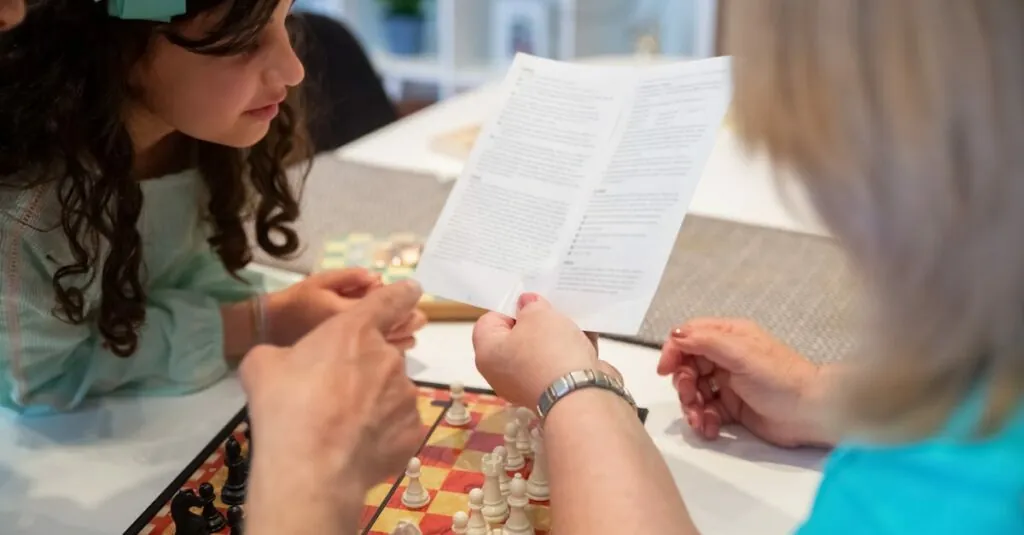Table of Contents
ToggleNavigating the world of co-parenting can feel like trying to assemble IKEA furniture without the instructions—confusing and a bit frustrating. Yet, with the right set of co-parenting rules, it can become a smooth process that benefits everyone involved, especially the kids.
Picture this: two parents working together, sharing responsibilities, and maybe even cracking a few jokes along the way. It’s not just about splitting time and resources; it’s about creating a harmonious environment where children can thrive. By establishing clear guidelines and open communication, co-parents can turn potential chaos into a well-orchestrated routine.
Understanding Co Parenting
Co-parenting involves shared duties and teamwork between parents after separation or divorce. Effective co-parenting relies on clear communication, where both parties express needs and concerns openly. Building a cooperative relationship fosters security for children, nurturing their emotional well-being.
Creating a parenting plan serves as a roadmap for responsibilities. This plan outlines schedules, educational decisions, and extracurricular activities, ensuring both parents stay aligned. Establishing consistent rules across both households helps children understand expectations, reducing confusion.
Flexibility proves essential in co-parenting situations. Life changes can lead to necessary adjustments in schedules or logistics. Approaching these changes with understanding allows parents to adapt without conflict.
Maintaining respect towards one another remains vital. Disputes may arise, but a respectful dialogue mitigates tension. Listening actively during discussions promotes a healthy co-parenting relationship.
Conflict resolution skills enhance co-parenting dynamics. Parents benefit from recognizing when to compromise and how to negotiate effectively. Utilizing third-party mediation can aid in resolving disagreements when direct communication proves challenging.
Finally, prioritizing the child’s best interest guides decisions. Focusing on what benefits the child should influence all aspects of co-parenting. By keeping the child’s welfare at the forefront, parents cultivate a positive atmosphere that supports their growth and development.
Essential Co Parenting Rules
Establishing fundamental co-parenting rules greatly enhances effective collaboration between parents. By focusing on communication, respect, and consistency, these guidelines create a supportive environment for children.
Communication Is Key
Effective communication forms the backbone of successful co-parenting relationships. Parents must stay open to discussing schedules and any changes that affect their children. Sharing information helps in aligning strategies, ensuring both parents remain informed. Addressing concerns promptly prevents misunderstandings and nurtures trust. Utilizing various communication tools, such as apps or shared calendars, simplifies coordination. Active listening plays a pivotal role; understanding each other’s perspectives fosters a cooperative atmosphere. When parents prioritize dialogue, they enhance the overall well-being of their children.
Respect Each Other’s Parenting Styles
Respecting differing parenting styles maintains harmony in co-parenting arrangements. Acknowledgment of unique approaches fosters understanding between parents. Embracing diverse strategies ensures children receive well-rounded experiences. When parents refrain from criticizing each other’s methods, they model healthy relationships for their children. This respectful attitude encourages collaboration and problem-solving. Recognizing that no single approach is perfect helps in crafting balanced parenting solutions. Prioritizing each parent’s strengths contributes positively to children’s development and promotes a cooperative dynamic.
Setting Boundaries
Setting boundaries proves vital in co-parenting. Clear guidelines prevent misunderstandings and foster a positive environment for children.
Establishing Ground Rules
Establishing ground rules helps define expectations between co-parents. Parents can agree on critical aspects such as communication styles, discipline approaches, and schedules. Creating these rules ensures that both parties understand their roles. Flexibility within these guidelines allows adaptation to changing circumstances. When conflicts happen, referring back to the established rules provides clarity.
Maintaining Consistency
Maintaining consistency across both households promotes stability for children. Similar routines, rules, and discipline methods create a sense of security. Parents should regularly communicate about any updates or changes to these practices. Sharing calendars or parenting apps simplifies coordination of schedules. Consistency reinforces the co-parenting partnership, making it easier for children to adjust and thrive.
Encouraging Healthy Relationships
Creating a healthy co-parenting relationship involves fostering positive interactions and prioritizing children’s needs. Both parents can work toward a supportive atmosphere that benefits everyone involved.
Fostering a Positive Environment
A positive environment promotes constructive communication. Establishing open channels allows both parents to share thoughts and feelings without judgment. Encouragement of teamwork reinforces a united front, which children can sense. Regularly checking in with each other strengthens relationships, ensuring alignment in parenting goals. Using neutral language during discussions avoids unnecessary conflict. Celebrating each other’s successes fosters mutual respect and understanding. Embracing shared parenting responsibilities cultivates a sense of partnership that directly benefits the child’s emotional stability.
Supporting the Child’s Needs
Supporting children’s needs requires active listening and awareness of their feelings. Both parents must prioritize the child’s emotional and physical well-being. Understanding that children thrive on consistency encourages similar routines and disciplinary approaches in both homes. Encouragement of open dialogue about feelings allows children to express concerns, knowing both parents will listen. Collaboration on education and extracurricular activities shows commitment to the child’s holistic development. Monitoring stress levels and discussing challenges help the child navigate difficulties with parental support. Consistent communication about their needs strengthens the co-parenting relationship and creates a nurturing atmosphere for growth.
Navigating co-parenting can be challenging but establishing clear rules and guidelines makes the journey smoother. By prioritizing communication respect and consistency co-parents can create a nurturing environment that benefits their children. Flexibility and teamwork are essential in adapting to life’s changes while maintaining a focus on the child’s best interest.
Fostering healthy relationships between co-parents not only enhances their partnership but also positively impacts children’s emotional well-being. With the right strategies in place co-parents can transform potential conflicts into opportunities for growth and collaboration. Ultimately a well-structured co-parenting approach lays the foundation for children’s thriving development and happiness.







